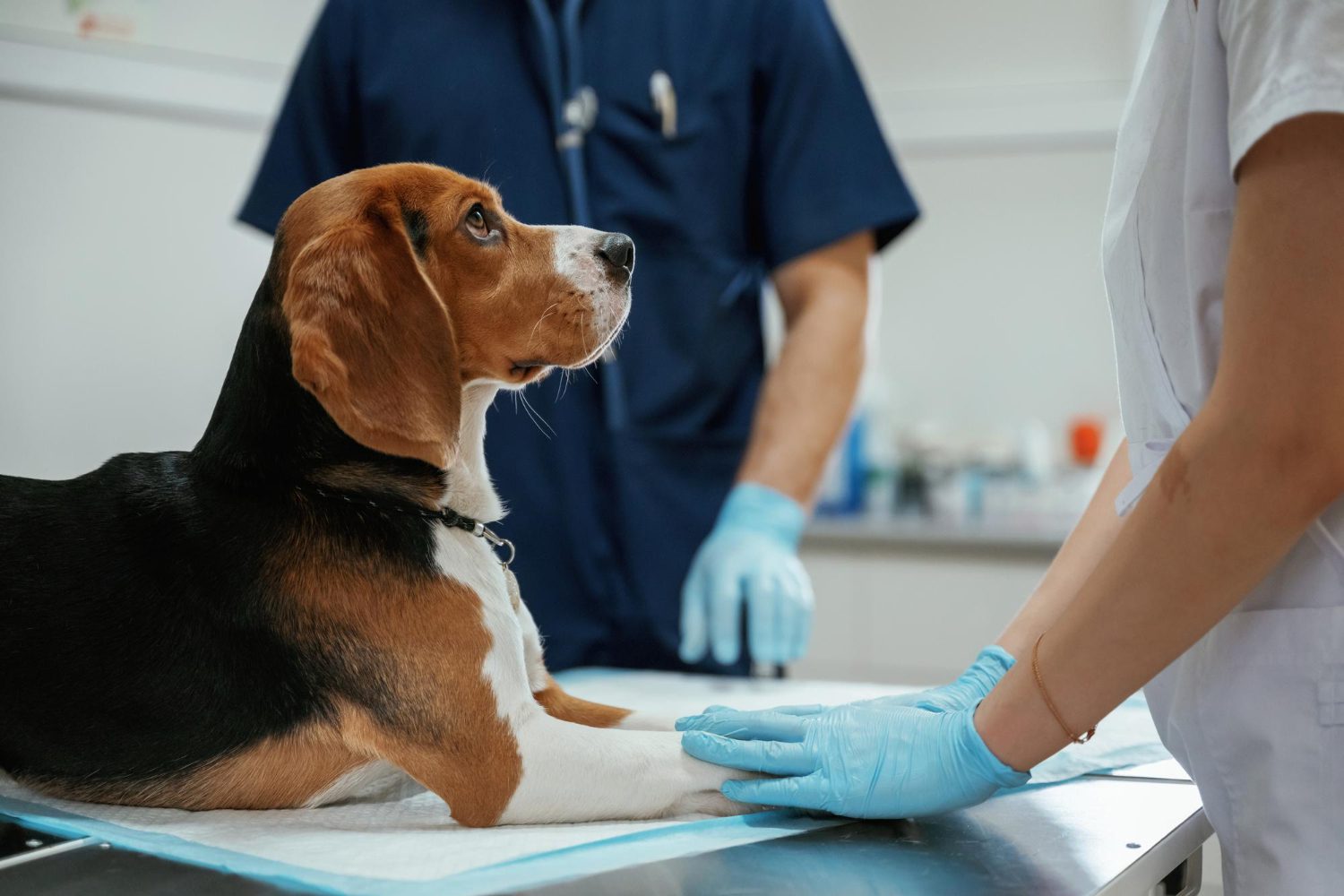Seizures in Dogs: Causes and Treatment Options

By Evelyn Harcourt
September 29, 2025 - 1 min read
A seizure is also called a convulsion; while it is happening, the dog is unaware of their surroundings and experiencing severe muscle tremors. It is not unusual for them to vocalise.
This article explores why seizures happen, what to expect before, during, and after, and discusses the diagnostic procedure and most common therapy plans. It also discusses the dog’s prognosis and what owners can do to try to minimise seizure occurrence.
As an owner, witnessing your dog have a seizure can be very upsetting. Many owners report feeling powerless. We hope to arm you with the knowledge you need to feel confident in managing your dog’s health.

What Are Seizures in Dogs?
A seizure is the result of a period of irregular electrical brain activity. Not only does the dog experience erratic and uncontrolled movement, but it also changes how it perceives the world around it.
How Seizures Affect the Brain and Body
A burst of electrical activity occurs within the brain, and this has a profound effect on the body.
The firing neurons lead to a loss of consciousness, convulsions, or uncontrolled movements.
Types of Seizures
There are a couple of types of seizures that dogs experience:
- Focal: This type of fit is also referred to as a ‘partial seizure’, and the effects are limited to one part of the body.
- Generalised: This type is also known as ‘Grand-mal’ in human literature, or as a ‘tonic clonic’ seizure. The dog loses awareness of what is around them, cannot react to you calling them, and their whole body is involved in movement and spasms.
Common Causes of Seizures in Dogs
When a dog has a seizure, this should be seen as a symptom rather than a diagnosis. It confirms there is an issue, but it does not tell us what is wrong.
Epilepsy
When we think of seizures, we tend to think of epilepsy, but it is just one potential cause. It is a diagnosis of exclusion. There is no specific test for it, and we can only be confident a dog has epilepsy if the other likely causes are ruled out.
Epilepsy is a genetic condition, and certain breeds are more prone to it. If a parent has it, there is a higher chance the offspring will be affected. Breeds typically affected include the Border Collie, Boxer, Golden Retriever and Cocker Spaniel.
Head Trauma or Brain Injury
A serious head trauma, such as a collision with a vehicle or a fall from a height, can lead to seizures.
The brain cells are damaged, and the electrical activity is interrupted and altered. Sometimes, abnormal pathways are created, meaning changes can be permanent.
Infections and Inflammatory Diseases
Some of the more common infectious and inflammatory disorders that cause seizures in dogs include toxoplasmosis, Distemper virus, and granulomatous meningoencephalitis.
Typically, these dogs will have other symptoms, as the diseases do not just affect the brain. For example, a dog with toxoplasmosis may also have a cough, vomiting, and eye inflammation.
Toxins and Poisoning
Certain toxins will lead to seizures, and some cases of toxicity seen more regularly in practice would include:
- Chocolate (especially dark chocolate or cocoa powder, due to the higher theobromine content).
- Plants like foxgloves
- Blue green algae
- Xylitol (a sweetener found in toothpaste and some foods).
- Certain human medicines, such as antidepressants.
Metabolic or Organ Disorders
An imbalance in the level of things like salts, sugars and toxins can all cause convulsions. Some examples would include ammonia buildup with a liver shunt or urea buildup in those with kidney failure.
In small breeds such as Yorkshire terriers and Chihuahuas, hypoglycaemia (low sugar levels) can quickly lead to fits. This can occur in young puppies who develop stomach upsets and stop eating.
Unmedicated Addisons’s disease may lead to seizures due to changes such as low blood sugar or low sodium.

Symptoms of Seizures in Dogs
Although some seizures are easily identified, others can be more subtle. They may be mistaken for something else- such as a fainting episode, or even behavioural disorders.
Early Warning Signs (Pre-Ictal Phase)
Before the fit even occurs, many owners will pick up that their dog is acting differently. The dog may act aloof or restless. Some go and hide, while others are extra clingy and begging for attention.
Dogs may be vocal and whine, and this period can last anything from seconds to hours.
What Happens During a Seizure (Ictal Phase)
When the dog is actively seizing, they will experience signs such as stiffening, limb paddling, urination, twitches, and tremors.
Most seizures last a few seconds or minutes, but some can go on for much longer (status epilepticus).
After-Effects and Recovery (Post-Ictal Phase)
Once the convulsions have ceased, your dog will take some time to act normally again.
This period can last up to 12 hours, and signs include lethargy, hunger, weakness, and even temporary blindness.

Treatment Options for Seizures in Dogs
A treatment plan will be developed, based on your dog’s needs and underlying medical issues.
Anti-Seizure Medications
If a dog has had more than a single seizure, they are often started on anti-seizure medicine.
There are several options, and it can be difficult to predict which will work for which dog. It is not uncommon to have to change to a different medicine or to add another one to the protocol if the patient’s seizures are not being well-controlled.
Usually, the owner is dispensed rectal Diazepam, which they can use from home should another seizure occur.
Emergency Seizure Management
In the moment, it can be very stressful when your dog starts to have a fit. For this reason, having an action plan is sensible.
Do not try to touch or move your dog, as you risk being bitten. Keep the surrounding area calm, quiet and dimly lit. Insert rectal Diazepam according to your vet’s instructions, if this has been prescribed for your dog.
If heat stroke is suspected, actively cool your dog down by putting cold water on their body (not head) and placing a fan directly on them.
If this is the first fit and you feel that you can, video the event to show to your vet. Any seizure lasting more than five minutes is a true emergency, and your dog should be transported to the local emergency clinic.
At the clinic, emergency management consists of intravenous anti-seizure medicine, oxygen, IV fluids, and reducing the body temperature if needed.
Treating Underlying Conditions
As fits are often a result of another medical issue, for these patients, it is vital that the problem is diagnosed and addressed.
This can mean surgical removal of a brain tumour or surgical correction of a liver shunt. It can also mean providing the appropriate medicine, such as in the case of a dog with Addison’s disease.
Prognosis and Long-Term Management
Your dog’s prognosis will depend on the reason they have had a seizure.
For those with epilepsy, the prognosis is generally good, and it is often possible to reduce the severity, duration and frequency of the fits with medication.
Factors Influencing Prognosis
Things like your dog’s age and general health will play a big role here, as will the official diagnosis.
Something like idiopathic epilepsy carries a much better prognosis than a brain tumour or end-stage kidney failure.
Your vet will talk you through your dog’s prognosis after they’ve performed a thorough assessment.
Monitoring and Follow-Up With a Vet
If pets are started on anti-seizure medicine, they will need to be seen regularly.
They will also need blood tests every few months to monitor the concentration of the drug in their blood and ensure their liver is not being negatively impacted.

Preventing Seizures in Dogs
While we cannot always prevent a seizure, certain things can have a significant positive impact.
Reducing Environmental Triggers
From home, it is wise to try to reduce the likelihood of a seizure occurring. This can mean:
- Avoiding very high stress situations, like large gatherings, dog kennels or firework displays
- Not having music or TV turned up very loudly
- Keeping a consistent and predictable routine
- Feeding at regular times
- Strict adherence when it comes to taking medicine
Diet
Recently, much research has been carried out regarding canine diet, supplements, and seizure prevention.
There has been some evidence that ketone production can lead to seizure reduction, and that feeding medium chain triglycerides (MCTs) may help stabilise neuronal activity in the brain. Purina now manufacture a dog diet rich in MCTs, aimed at those who experience seizures.
Explore More About Seizures in Dogs
When your dog has a seizure, it can raise a lot of worry and questions. Please contact us to talk to a member of staff if you have concerns for your pet or need more information.
Seizures in Dogs FAQs
Are Seizures in Dogs Fatal?
Although rare, a seizure has the potential to be fatal. This can be seen when the seizure is prolonged and the core temperature elevates to a point where the brain and other organs are permanently damaged.
What Should I Do If My Dog Has a Seizure at Home?
Firstly, try not to panic. Ensure the area around your dog is safe and that there are no sharp or hard areas they could bang. Time the seizure, and contact an emergency vet if it continues for more than 5 minutes.
Can Stress Cause Seizures in Dogs?
Stress will not cause a fit in a healthy dog, but highly stressful situations may cause seizures in a dog who is already predisposed to them.
How Long Can a Dog Live With Epilepsy?
The prognosis of a dog with well-controlled epilepsy is very good, with many having normal life spans. However, dogs do need regular veterinary checkups, and many are on lifelong medication.
Continue reading

Is Excessive Drooling An Emergency for Dogs?
Excessive drooling in dogs: causes, red flags, and when to call the vet.
Read article
Cat Tail Shaking: Is it an Emergency?
Learn whether your cat's tail shaking is normal, a warning, or urgent.
Read article
Eclampsia in Dogs: Symptoms, Causes and Treatments
Spot eclampsia fast, symptoms, causes, and vet treatments to protect mum and pups.
Read article